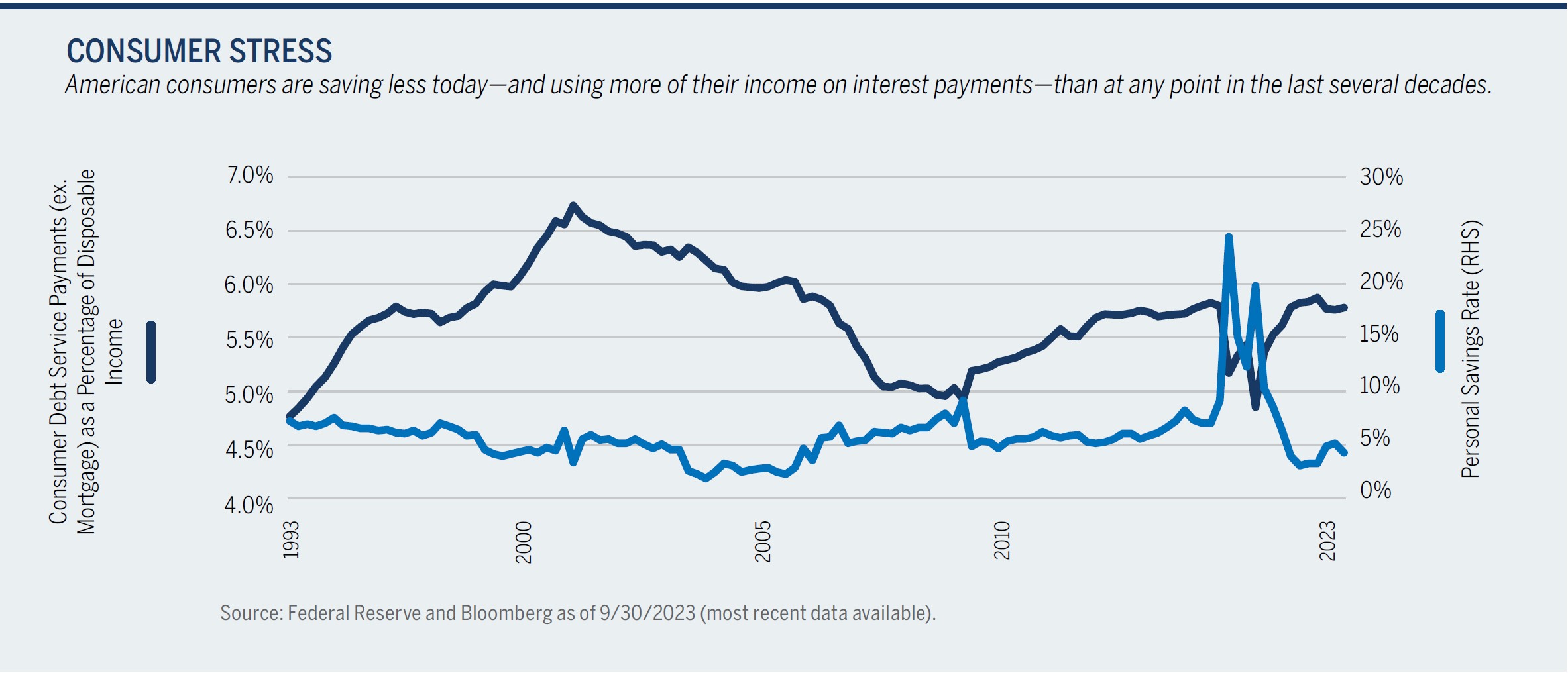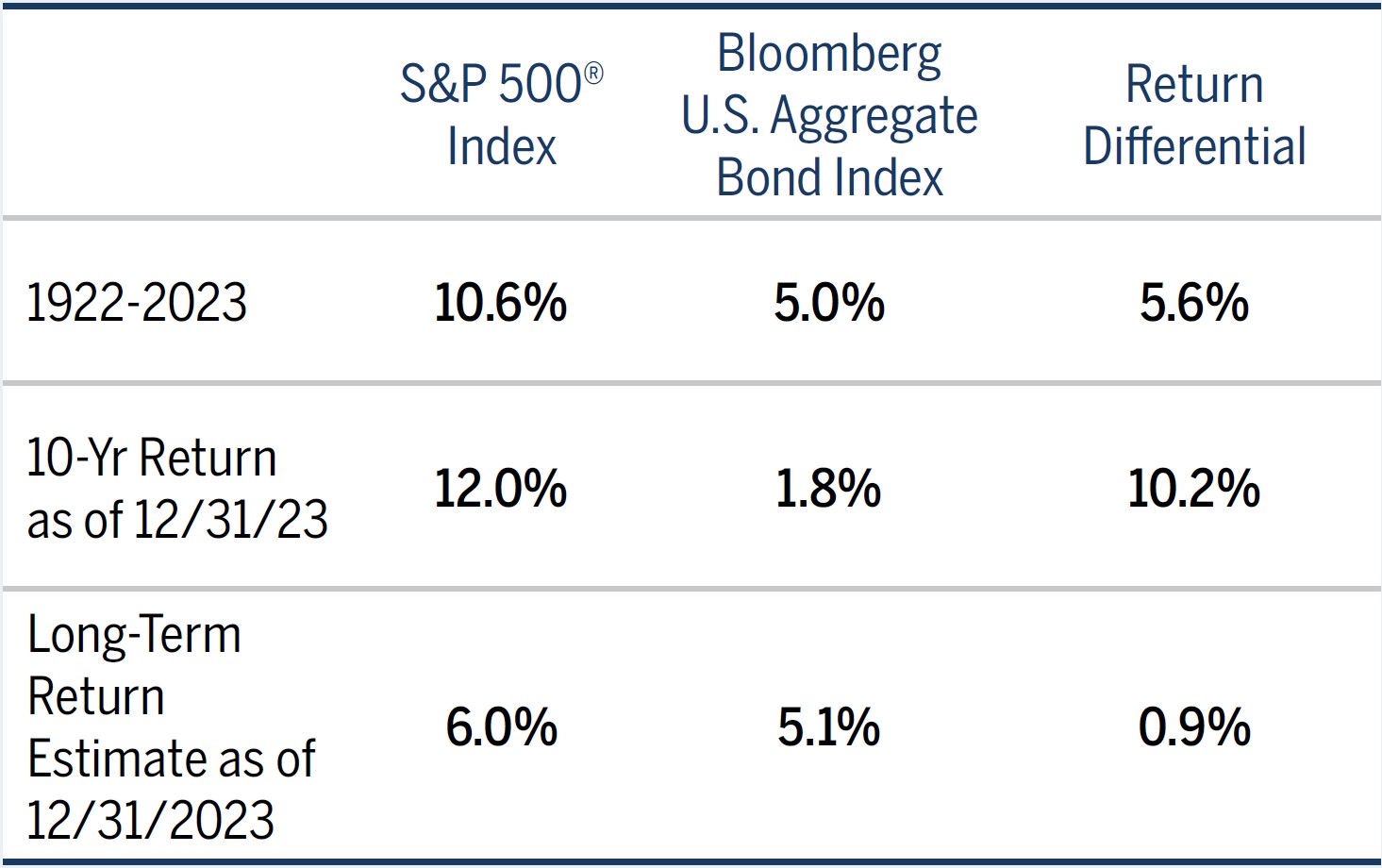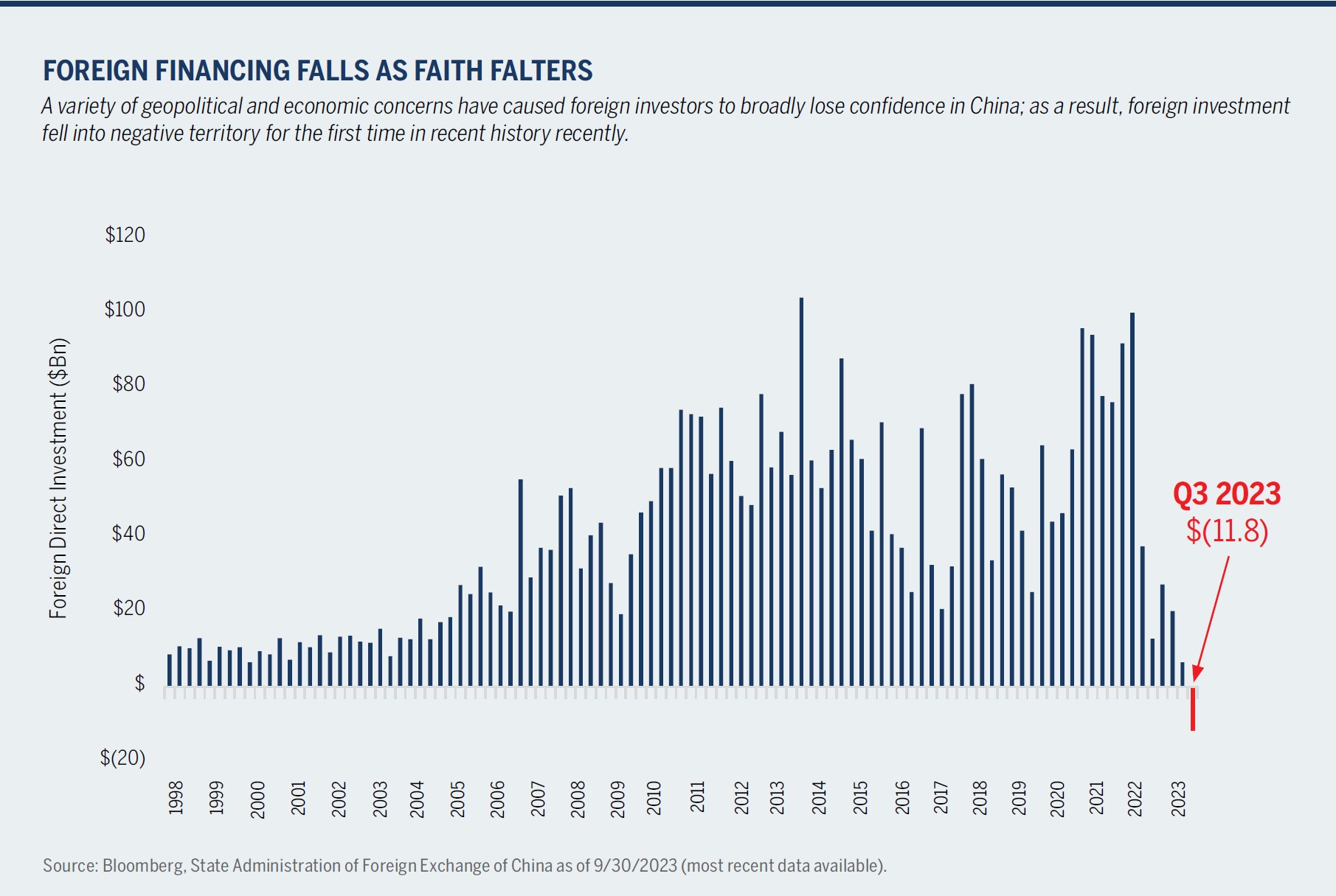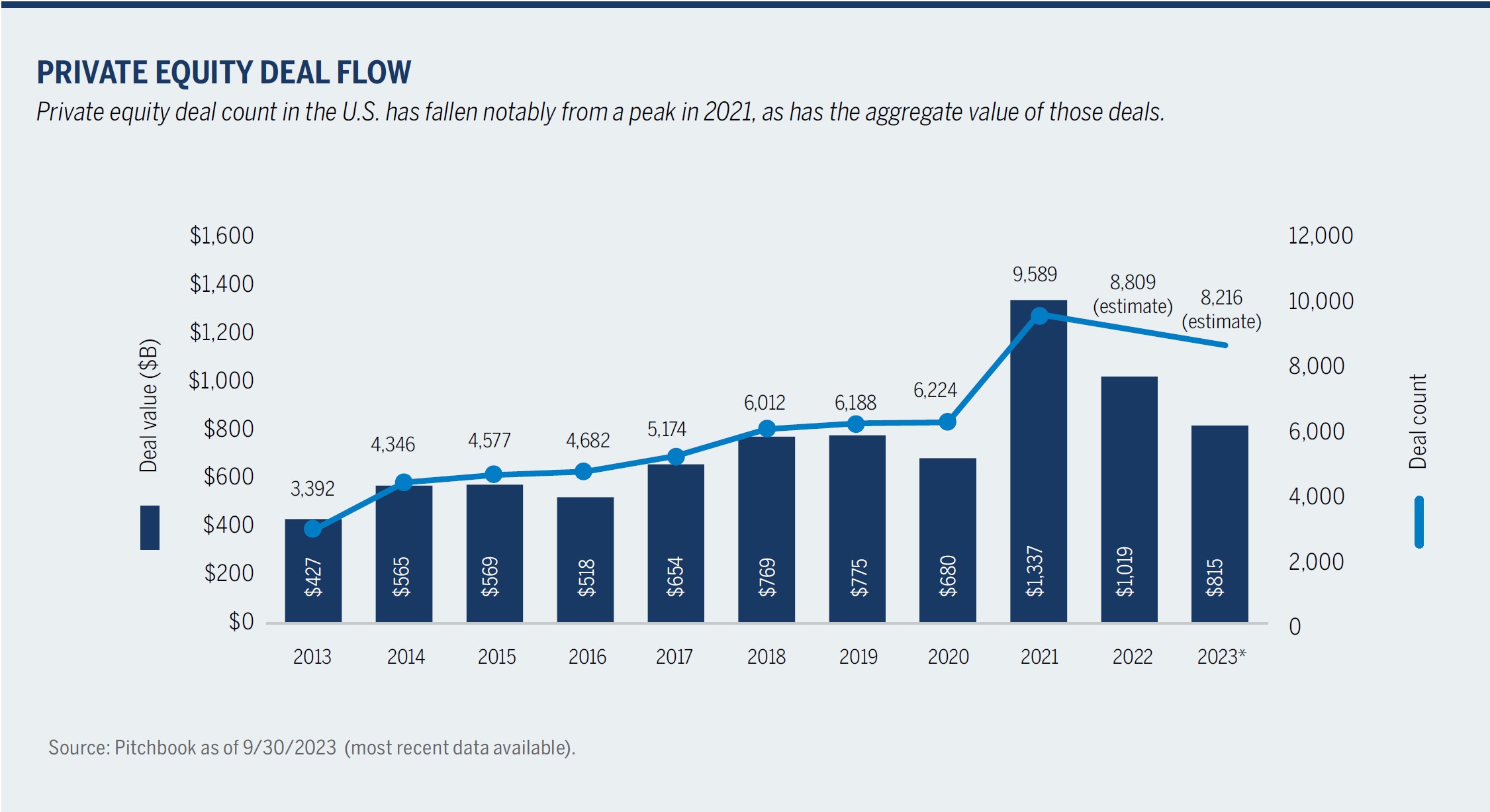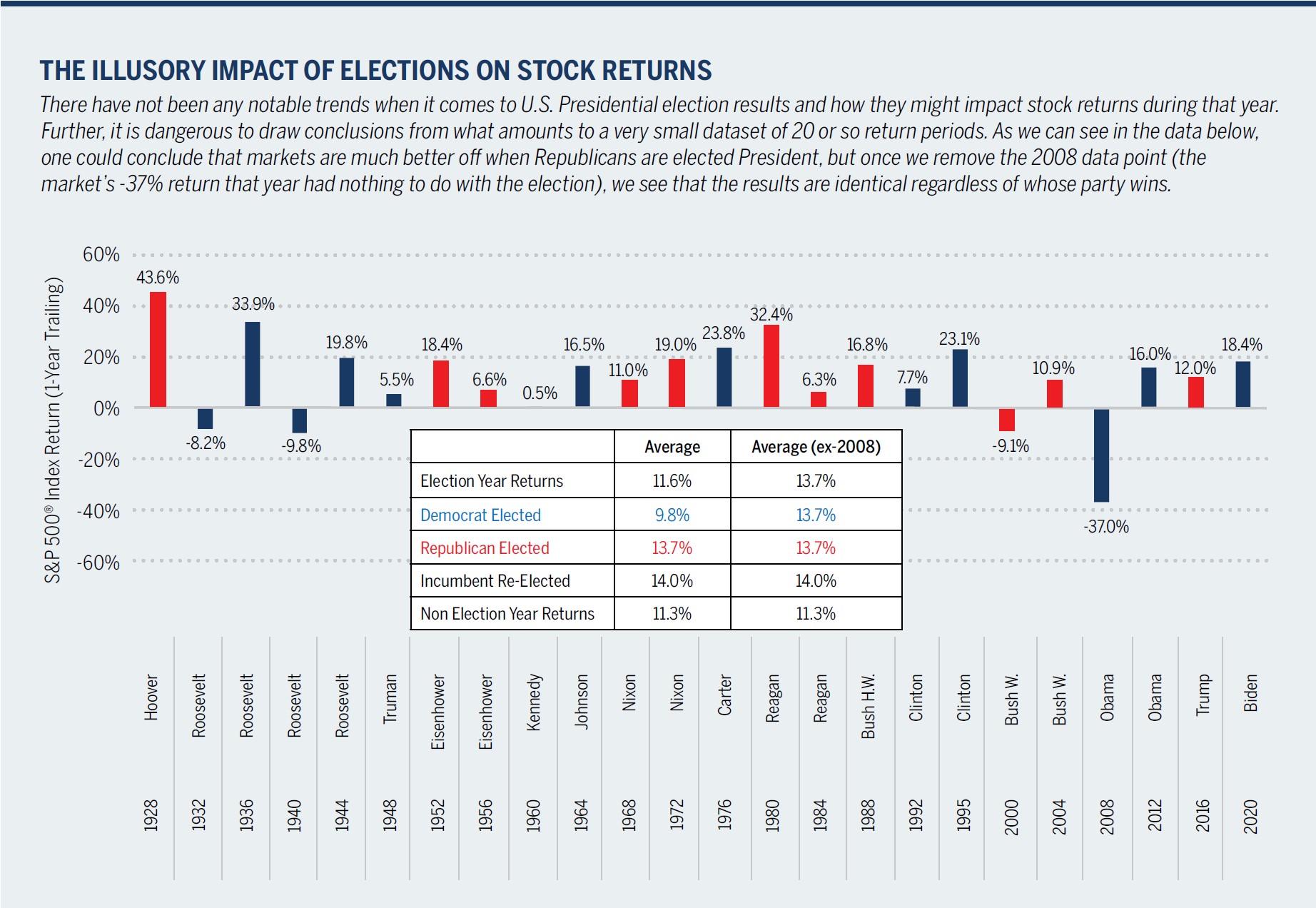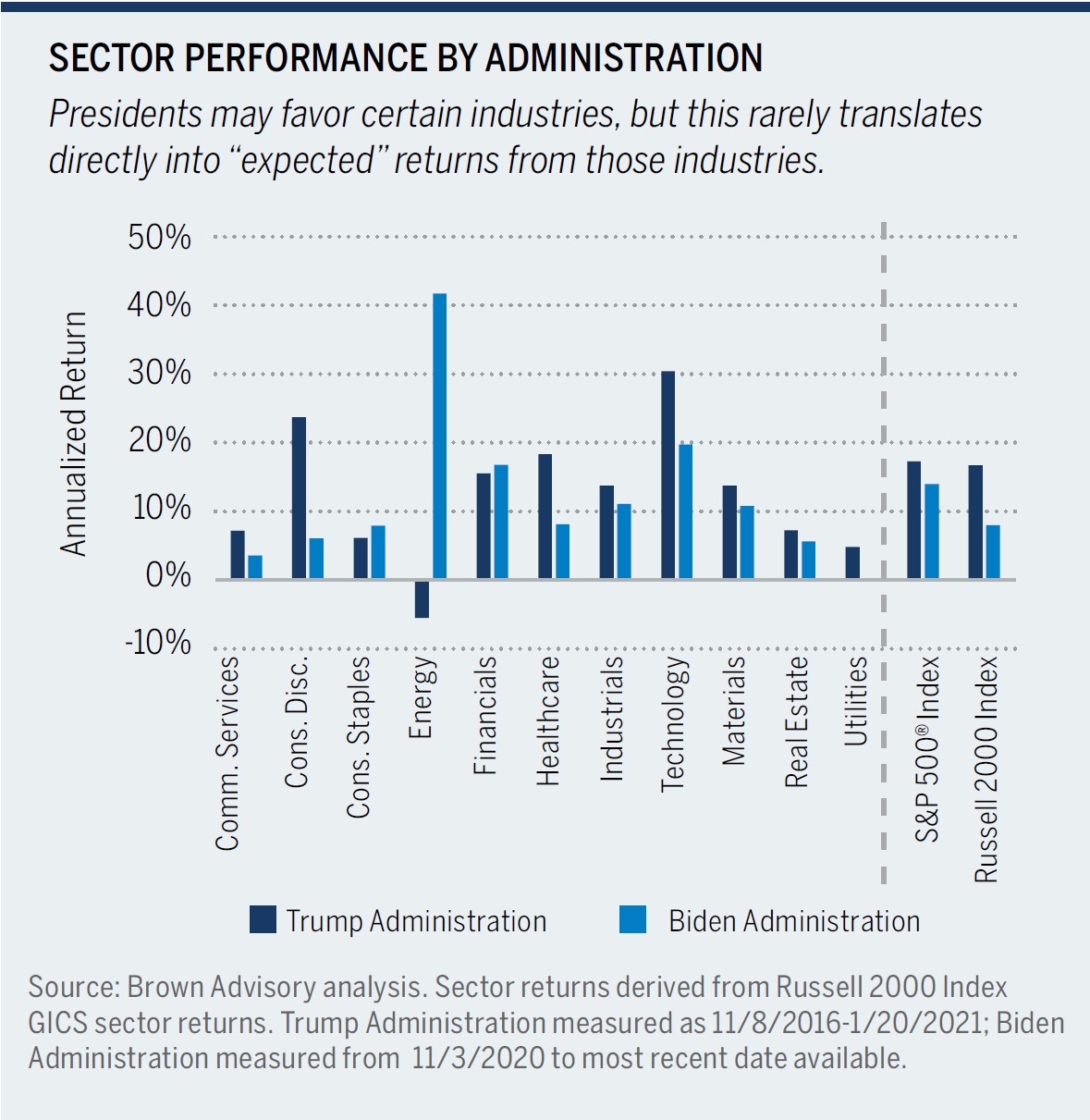INVESTMENT LANDSCAPE
HIGHLIGHTS
Despite fears of a macro-driven correction due to rising rates and inflation, markets showed surprising resilience last year.
We are monitoring several risks at the start of 2024, from weakening consumer balance sheets to the pending 2024 U.S. elections. Despite these medium-term pressures, we remain optimistic about long-term prospects for growth, especially given the transformative potential of innovations within AI and with GLP-1 treatments.
The story of financial markets in 2023 can be summed up in two words: surprising resilience.
Stubborn inflation, alongside the most pronounced interest rate hikes of the past 40 years, led many to expect a U.S. recession in 2023. As the year progressed, we witnessed large U.S. bank failures, repeated threats of U.S. government shutdowns, the disappointing re-opening of China’s economy, continued war in Ukraine and war in the Middle East.
If you had given us this script in advance, we would not have predicted a favorable outcome for markets, much less a 26%+ return for the S&P 500® Index!
There are several reasons why these results were a positive surprise: excess savings from the pandemic being unleashed, elevated deficit spending from governments, excitement about artificial intelligence and the continued growth of cloud computing. The “AI craze” specifically favored seven massive technology companies (Apple, Microsoft, Alphabet, Amazon, Meta, Tesla and NVIDIA) that have dominated the U.S. market for years. These “Magnificent Seven” companies rose by 107.0%, while the rest of the S&P 500® Index rose by only 12.5%, making 2023 the narrowest market in decades.
Additionally, inflation finally saw meaningful deceleration in the latter part of the year, with core inflation falling within reach of central bank target levels in both Europe and the U.S. by year’s end. This also helped give markets confidence that a quick pivot by central banks to lowering rates could generate a soft economic landing (i.e., bring inflation down without a recession). However, it is important to remember that despite the drop in bond yields during the fourth quarter, interest rates were still higher across the curve in 2023 (even following the historic increase in rates during 2022). Therefore, it is far too soon to say how the recent slew of rate hikes will impact the economy in 2024 and beyond. Decades ago, Milton Friedman helped us understand that the Fed’s interest rate decisions are not tweaks with immediate results; instead, their effects have “long and variable lags,” and it can take years to fully see these effects filter into markets, especially into other debt markets (source: “A Program for Monetary Stability,” by Milton Friedman).
These lags may be even longer than usual during this cycle. U.S. consumers took advantage of what were low mortgage rates—mortgages make up 70% of the typical U.S. household’s debt, and four out of five U.S. 30-year mortgages are at or below 5%. These homeowners’ mortgage costs are likely lower than the interest they earn from most savings accounts; they are well shielded from the economic pain of higher rates. Similarly, corporations took advantage of the prior decade’s low rates, extending the average duration of corporate debt from six years to nine years between 2012 and 2022. Thus, corporations and U.S. consumers both had some built-in padding that protected them from higher debt costs in 2023.
The situation in Europe is more complicated, however. Mortgage markets differ by country but suffice it to say that in most European countries, mortgages tend to be much shorter in duration. In the UK, for example, the majority of fixed-rate mortgages have a duration of between two and five years, after which they begin to rise and fall with interest rates. In Germany, things look a bit better with a growing proportion of borrowers recently opting for fixed-interest periods greater than 10 years, but there are still many pockets of Europe with meaningful exposure to variable-rate payments. The full impact of higher rates on the European consumer is arguably yet to be felt, so we remain cautious on the outlook, especially given European economies remain susceptible to the prospect of higher energy prices should the continent fail to be blessed with another mild winter.
Globally, barring a quick reversal in interest rates, those interest costs will likely increase over time. People need to sell homes, companies need new debt financing, and all of that will likely be more expensive going forward. Mortgage rates in the U.S. are near 7% at the time of this writing and briefly exceeded 8% during Q4 2023; 10-year U.S. Treasury yields had hit 20-year highs, while credit card APRs were at or near 30-year highs. Economic conditions in Europe are just as tight, if not tighter, given a higher reliance on bank credit, less fiscal support, a greater dependence on energy imports and an economy more exposed to global trade.
It is only a matter of time before these effects are felt in a more material way. Consumers are saving less today—and using more of their income to service their debts—than they have in 15 years (see chart below). Credit card and auto loan delinquency has started to rise, reaching pre-pandemic levels. Companies are starting to mention the impact of higher rates on consumer demand. All of this is starting to show up in reduced forward earnings guidance for some companies.
Paid to Wait
The looming impact of higher interest rates is one justification for caution as we look forward. Another, more positive reason, is that for the first time in more than a decade, investors are being paid well in defensive assets like cash and bonds. Real interest rates (i.e., nominal rates minus inflation) stand at multi-decade highs; meanwhile, stock market valuations are still elevated, especially after the Fed pivot-driven rally in November and December, which dampens their future return outlook from here.
The combined effect of these two trends is that bonds and cash simply “compete” much more effectively with stocks now than they have in a very long time. The “equity risk premium” (i.e., the estimated. incremental return from stocks vs. bonds) is currently at its lowest level in nearly 20 years—in other words, expected bond returns have nearly “caught up” with stocks (see table at right). Historically, stock returns have nearly doubled those of bonds (and for the past decade, absolutely trounced them), but today, expected returns are neck and neck.
THE "NEW ABNORMAL"
Historically, stocks and bonds have both offered desirable, risk-adjusted returns, with stocks offering a greater return. Over the past decade or so, this “truism” became untrue, as bond returns plummeted to less than 2%. However, with higher interest rates, we anticipate bonds will likely produce a more competitive return compared to equities going forward.
Source: Bloomberg, Brown Advisory analysis as of 12/31/2023.
Specifically, even when considering the recent drop in interest rates, longer-term rates (e.g., 10- and 30-year bonds) now allow investors to lock in positive real yields for many years into the future. This has given us confidence to extend the duration of our bond portfolios, which offers us some protection if economic growth slows further from here.
Despite the delayed impacts of central bank rate hikes, there are already winners and losers in an environment in which rates may stay “higher for longer.” Companies with too much debt, particularly the floating-rate variety, are struggling, as are unprofitable companies that need more capital and whose earnings are not expected to materialize in the near term. As quality-oriented investors (see: “High Quality Stocks for the Long Run?”), we prefer investments with lower debt levels and healthy free cash flow generation, and we believe that this preference should serve us well—especially during a period when access to low-cost capital will likely be quite limited. We are beginning to see opportunities in more distressed areas of the market but are moving slowly given the environment.
Increased debt costs may be a drag on shareholders and asset owners, but they are conversely a potential boon to lenders. The pullback in bank lending after the failure of Silicon Valley Bank, the pressure on companies with high levels of floating-rate debt, and the necessary recapitalization of many real estate properties have provided ample opportunities with attractive risk/reward. There are real problem loans from commercial real estate properties that sit on bank balance sheets today, and the severity of potential losses is just beginning to appear. We have seen a few office properties across the country sold at 50%–75% discounts to where they traded just a few years ago, and that is leading to not only a wipeout of equity holders, but also losses for lenders. The good news is that most of the largest banks have quite limited exposure to such loans and are well capitalized, with tightened oversight from regulators since 2008. We view the broader financial system today as sound. Many smaller regional or community banks in the U.S., that have far greater office loan exposure as a percentage of their assets, are struggling; they have slowed their pace of lending and may be forced to sell loans or assets at steep discounts. We have shifted more of our investments toward credit investments this year as a result of this dynamic and are continually evaluating new opportunistic distressed investment strategies focused on real estate.
Beyond the Magnificent Seven
Looking forward, another “trend” we are watching is more accurately described as an “anti-trend.” The stellar performance of the “Magnificent Seven” tech giants in recent years has resulted in large swaths of the broader stock market being heavily undervalued on a relative (and in some cases absolute) basis. We haven’t seen this level of market concentration since the 1970s. Those seven stocks drove 70% of the market’s return in 2023, and as of the time of this writing they trade at an aggregate valuation of more than double that of the rest of the S&P 500® Index. We still think several of these companies represent excellent long-term investments, but this concentration within major indices (to which so much capital is implicitly or explicitly tied) creates significant risks particularly given the thematic similarities within these companies. For all these reasons, we continue to shift capital on the margin to smaller companies and to non-U.S. opportunities in search of more attractive valuations.
Europe: Despite the challenges outlined above, our managers are broadly seeing more opportunities emerge in European-listed companies, as negative sentiment on the continent as a whole has disproportionately weighed on the share prices of a select group of business models. Companies like the London Stock Exchange Group have been treated as European market-sensitive cyclicals, but in reality, they are market-leading firms with diversified, global businesses and strong secular growth drivers. Global aerospace leaders Safran and Airbus reside in Europe; we believe that their high return on invested capital positions them very well, even before considering the benefit of any potential cyclical rebound from the pandemic, or from secular growth in travel. Broadly, valuations are cheaper in Europe than the U.S. and we are optimistic that bottom-up research can continue to unearth attractive investments there.
Asia: We had a number of our research team members travel to Asia this year, in hope of gaining insight into China’s recovery falling short of expectations, as well as Japan’s markets surprising many with their renewed vigor. We remain convinced that China still merits investor attention, with a plethora of quality growth companies, market inefficiency that rewards solid fundamental research and low valuation relative to its own history. However, these positives are being overshadowed by the growing uncertainty of the government’s ongoing support of free markets, China’s looming real estate debt woes, and the country’s highly challenging demographics. The demographic situation is more dire than many realize; China’s birth rate has dropped by 40% since the start of the pandemic, and recent estimates suggest its working-age population may decline by 20% in the next 20 years—a potentially MASSIVE drop in overall production (equivalent to ~40 million workers leaving the U.S. workforce over a similar timeframe). Meanwhile, Xi Jinping’s consolidation of power and the Party’s various steps to retreat from market-oriented capitalism have undermined business and investor confidence and pushed foreign direct investment into negative territory for the first time on record (see chart below).
At this point, we favor a pan-Asian approach to our allocations in the region. We are focusing more research on Japan, where inflation has been a welcome change after decades being mired in deflation. Japan’s wage growth and retail sales trends are each at 30-year peaks. Renewed regulatory pressures aimed at profitability and governance also present an opportunity for both margins and valuations to improve in Japan—something that can’t be said of many markets in the world.
Private Markets Stalemate
Private market deal volumes are at their lowest point in years, and valuations for these deals are in a state of flux despite solid fundamental performance from many underlying private companies in our buyout portfolios and properties in our real estate portfolios. Growth has certainly slowed in our venture portfolios, but many of our venture-backed companies have tightened their belts, reduced their cash burn and are charting a path toward profitability. Still, losses are very likely to materialize in many venture portfolios as this segment of the market continues through its natural cycle.
Deal pricing remains a challenge, and at times valuation debates can lead to a stalemate when buyers and sellers are unwilling to acknowledge shifts in market realities. Higher financing costs typically lead to lower cash flows, and higher interest rates typically lead to lower multiples paid on those cash flows. Can buyers and sellers agree on these projections, and on what they imply for valuation? And can a buyer get financing for their purchase at rates that make the valuation work? The continued concerns over an economic slowdown have also served to dampen this market.
Private valuations and marks have fallen steadily coming out of the pandemic and are now more in line with public comparables. They very well may have further to fall. That said, we believe deal activity may increase in the near future, as the reality of higher rates sets in and the need for capital forces sellers to the table with more reasonable expectations. In general, we would expect to see higher capital call activity this year, and a continuation of a lean period for distributions in private investment portfolios.
We have favored allocations to debt over equity for many of our commitments in 2023. Earlier, we mentioned the more favorable comparison between debt and equity in public markets, and that is happening in private markets as well. Investors are being offered excellent returns for private credit risk at the moment. In the equity commitments we have made, we have favored cash-flow-producing investments, given the continued uncertainty with respect to both the economy and the valuation environment.
Regardless of the sector, we remain highly aligned with our top managers, and are broadly resisting the instinct to indiscriminately cut back on allocations. Private equity deal activity slowed yet again in 2023, with most investors pulling back. Investors have been rewarded over time for leaning in during periods like this, especially with managers that have demonstrated their skill across full market cycles. Of course, all private investments need to be weighed against each investor’s risk profile and circumstances, particularly in tougher market conditions.
Buckle Up for a Big Election Year
Some 40 countries, representing nearly half of the world’s population and GDP, will have national elections in 2024. Historically, elections have not had extreme impacts on markets, and we would find it difficult to draw conclusions about market performance even if we could predict the outcome of the election, which of course we cannot. (We do acknowledge that the upcoming U.S. presidential election has the potential to drive greater volatility than most).
Over the past century, S&P 500® Index returns in election years were, on average, slightly higher than in non-election years. Returns historically were better when a Republican won, as shown in the chart below. However, election years may also be accompanied by financial crises, global wars and/or a wide variety of economic scenarios, which often overwhelm political results.
For example, in the chart below, we summarize average results over the past century, and then offer the same summary excluding the outlier results of 2008. You will see that without the market results from the 2008-09 credit crisis, the data now “suggests” that election years offer notably higher returns, and the results are equal when Democrats and Republicans win. Further, we can see that “expected” sector returns under Republicans and Democrats do not always fit expectations (see chart on page 10); for example, a “political investor” likely would have chosen to invest in the energy sector under Trump and not under Biden, which would have led them to a weaker return. We believe that it would be foolhardy to draw investment conclusions about election years using the very noisy historical data available to us.
The U.S. stock market fared well under both Trump and Biden, but it would be impossible to assign credit to either administration for positive returns in recent years. Trump’s tax cuts likely helped, as has Biden’s infrastructure spending; however, one could argue that consistent 7% fiscal deficits under both administrations, 0% interest rates up until very recently, and massive technology disruption have all been bigger factors. As is often the case, we may want to give less credit to “the economy” and more credit to the fundamental successes of well-run companies like Microsoft, Amazon and the other tech titans that have propelled investor fortunes through the past two presidential terms.
All that being said, this election does stand out. Both Biden and Trump would be the oldest person ever sworn in as president, so questions regarding their health complicate matters. Meaningful legal troubles add yet another dimension of uncertainty to the equation. Further, we fear another election when the validity of the process is challenged, especially at a time when trust in government is at an all-time low (just 16% of Americans trust the government to do what is right, down from ~60% two decades ago). Third-party candidates may create more volatility than normal, in a year when the likely nominees from major parties both have track records as sitting presidents. While any one of these scenarios could rattle markets, they are unlikely to materially shift our assessment of individual investments, and we would seek to capitalize on buying opportunities that may emerge from any volatility.
As for potential changes in policy, either administration would be faced with the expiration of Tax Cut and Jobs Act provisions, which would mean higher marginal income tax rates and a halving of the estate tax exemption. Today’s lower corporate and capital gains tax rates are not set to expire, but they may become political issues given higher interest rates and heavy ongoing deficit spending. Biden’s 2024 budget proposal suggests increases to taxes, while Trump has suggested lowering corporate taxes further—in other words, both candidates are consistently representing their parties’ traditional tax views. However, a dysfunctional Congress may prove to be an immovable obstacle to either party’s plans.
End of the Free Money Era: The Bright Side
For us, investing does not involve “placing bets” that require a singular market or economic outcome to pay off. Instead, we prefer to mitigate risk by spreading it out: We examine multiple possible “bull” and “bear” scenarios, estimate the probability of those scenarios as best we can and prepare our portfolios to perform well in as many likely scenarios as possible.
In looking at these various potential scenarios for 2024, we see an elevated probability of recession in both the U.S. and Europe. Inflation, despite a large and welcome decline in late 2023, still remains above the comfort zone for central bankers on both sides of the Atlantic. There is a high likelihood that both inflation and interest rates may remain high relative to the past decade. There is also a risk that war in the Middle East or Eastern Europe spreads, straining global energy supplies and potentially sparking renewed inflation.
At the same time, governments in the developed world are facing a growing issue with debt and deficit spending: Levels that were largely sustainable with low interest rates are increasingly unsustainable now that rates have risen so notably. Addressing the overarching situation may require a combination of increased taxes, lower government spending and/or cuts to entitlements (more on that later). The debt ceiling debate in the U.S. has shed some light on this issue, but it still appears underappreciated by most investors, in our view.
This collection of market risks confronts stock valuations that are above their long-term averages (particularly for U.S. large-cap stocks) and well above where they typically sit when interest rates are at these levels.
With all of this in mind, we remain committed to our portfolio investments in quality public companies; long-term compound growth from public equities is the primary driver of wealth creation for most of our clients, and we expect that to remain true in the future despite current market challenges. However, we are tilting portfolios toward the opportunities we see in fixed income and credit and shifting some capital away from the “Magnificent Seven” and other market segments with lofty valuations, to spots where valuations appear more attractive.
As we mourn the end of the free-money era (2023 saw the first positive real interest rates from the Fed in more than 13 years), we should also celebrate that ending. In a healthy market, there should be a cost of capital—it should not be free to everyone, and now that it isn’t, we believe it will be a good thing in the long term for both fundamental investors and the economy alike. Going forward, cash-burning companies with flawed business models will likely consume far less productive capital than they did during this era. Investors are once again being rewarded for their focus on cash flows, rather than simply riding on the tail of an exciting narrative about the latest unproven market. The pendulum has swung back in favor of the providers of capital (investors) relative to the consumers of capital (companies, properties, etc.), and this should reward thoughtful, active investing.
The new interest-rate reality also lets us return to more balanced portfolio construction. No longer does one need to heavily allocate to risky assets to reach attractive return targets. We think constantly about the individual goals of each portfolio—who is the client, what are the funds for, when are the funds needed, etc.—and tailor allocations accordingly. For pools of capital with shorter time horizons, such as a foundation that is spending down its assets, or an individual nearing retirement, it is far more attractive today vs. 10 years ago for such clients to shift toward fixed income opportunities.
Despite higher rates and our somewhat cautious outlook, we remain open to the potential positive scenario of a soft landing in the U.S.—one in which inflation falls further, the Fed cuts rates meaningfully and parts of the industrial economy rebound to offset consumer weakness. If this past year has reminded us of anything, it is that predicting both economic and market outcomes is a challenging endeavor. To put it more bluntly, everyone in the investment business tries to anticipate where markets are headed next, and the best of us get it wrong nearly half the time. The vast majority of finance professionals greatly underestimated the strength of the U.S. economy in 2023, and it wouldn’t shock us if the same occurred in 2024.
While economic prognostication is nearly impossible, it is far more possible to make reasonable projections about companies and industries. We find it most useful to orient our thinking around the intrinsic value of individual investments, and then shift portfolio weightings based on those observations. When assets appear cheap to our estimate of value, we shift capital in that direction. What strikes us today is the disparity between the valuations of various companies based on their fundamentals, as well as disparities between small- and large-cap companies, and between international and U.S. markets—in each of these cases, there is healthy fundamental and valuation evidence leading us to lean in specific directions. This is a welcome development after years in which macroeconomic stresses continually swamped the market’s ability to separate the good from the bad. We hope these new realities will buoy our efforts to outperform our client’s blended benchmarks over the long term.
Note: All commentary sourced from Brown Advisory as of 12/31/23 unless otherwise noted. Alternative Investments may be available for Qualified Purchasers or Accredited Investors only. Click here for important disclosures, and for a complete list of terms and definitions.

